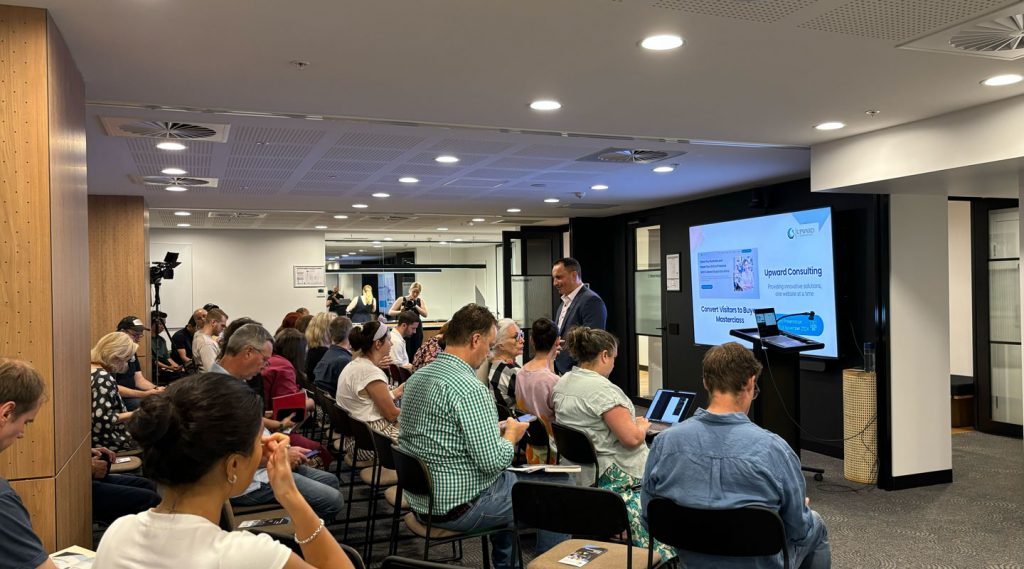Looking to transform your website from a passive online presence into a powerful sales tool? Discover the five essential elements that can help you capture attention, communicate value, and convert visitors into loyal customers.
In a recent workshop at the Brisbane Business Hub, digital strategy expert Dorin Blaga shared his proven tactics to optimise your website – ensuring it works as hard as you do to bring in leads and drive sales.
Blaga, the CEO and Founder of Upward Consulting, is a seasoned software engineer and digital strategist with over two decades of experience helping small and medium-sized businesses thrive through digital innovation.
Blaga’s passion for delivering real results was evident throughout the workshop, as he guided participants through five key website elements to drive conversions, improve engagement, and ultimately boost sales.
Here are five key takeaways from the workshop.
Create a clear and compelling header

Blaga stressed the importance of a website header that communicates a business’s value proposition in just a few seconds.
“Your header needs to grab attention and encourage action,” he explained. “It’s essential that it passes what I call the ‘Grunt Test’ – visitors should instantly understand your offer, why it’s valuable, and how to engage.”
For a header to be effective, it must answer three key questions: What do you do? How do you make my life better? How can I engage or buy?
Blaga cited research from the Nielsen Norman Group showing that visitors often decide within 10 to 20 seconds whether to stay on a website. A compelling header that clearly communicates the value proposition can extend this attention span, giving visitors a reason to explore further.
Your header should be bold and direct, explaining what your business does in a concise way. Avoid jargon or complex language—visitors should grasp your offer within seconds. “A clear, bold headline should convey your core message immediately,” Blaga noted.
The header area’s visuals should reinforce the message, focusing on an outcome that customers seek – if you provide a service for parents, for instance, show a relaxed, happy family, rather than a stressed out mum. Blaga explained that the visuals should “grab attention and reinforce your message without overwhelming the text”.
Blaga suggested following the headline with a brief subheadline that provides context. This can explain the core benefits of the service or product, outline the target audience, or clarify any key details – like the simplicity of engaging with your business.
These steps help ensure that the header makes a strong first impression and sets the tone for a seamless, engaging experience throughout the website.
Position your product or service as the solution
A critical component of converting visitors is positioning your product or service as the ideal solution to their problems.
Blaga emphasised the importance of first understanding the specific pain points that your potential clients face. “Identify the problems your customers face and show how your service is the solution,” he advised. “Highlight three key pain points your ideal client may have and align your offerings as the solution.”
Blaga explained that effective messaging goes beyond listing features; it’s about connecting with your audience on a personal level. He encouraged attendees to frame their products as problem-solvers, offering a clear pathway from pain to relief.
For instance, rather than simply saying “we offer marketing services”, the messaging should speak to challenges like “struggling to reach your audience” or “feeling overwhelmed by social media”, followed by a statement of how your service can alleviate these concerns.
Blaga also cautioned against relying solely on tools like ChatGPT for this purpose without careful customisation. While tools like ChatGPT can be fantastic aids in writing copy, it’s crucial to ensure you’re feeding these tools the right information.
“In programming, there’s a saying: ‘Garbage in, garbage out,’” Blaga said. “Our goal isn’t to become like AI; it’s to use AI to assist us. At the end of the day, we’re people talking to people, working to solve real problems.”
By keeping the human element at the forefront and speaking directly to real issues with genuine empathy and understanding, businesses can create copy that resonates authentically and effectively.
Leverage lead generators effectively

Blaga highlighted that most people landing on your website are not immediately ready to make a purchase. Instead of expecting instant sales, Blaga suggested a strategy centred around building trust through valuable resources. By offering high-value lead magnets, such as free guides, consultations or health checks, businesses can engage visitors who may still be in the research phase, gradually nurturing these leads into potential clients.
“Free value builds trust,” Blaga explained. “If we give visitors something worthwhile, we can keep them engaged and connected.” Offering a resource that addresses a common question or problem not only provides immediate value, but also positions your business as knowledgeable and helpful in your field. This approach opens a line of communication, allowing you to nurture leads and keep your brand top of mind as they move closer to a buying decision.
Blaga also shared practical advice for presenting these lead magnets effectively. He recommended using strategically placed pop-ups, banner ads, or dedicated sections on the website that gently draw attention to these offerings without being disruptive. He stressed that lead generation elements should be seamlessly integrated into the website experience, guiding visitors to helpful resources without interrupting their journey. For instance, an exit-intent pop-up could offer a downloadable guide as a “last chance” freebie for visitors who might otherwise leave without engaging further.
By embedding valuable lead generators throughout the site, companies can build relationships with potential customers and keep them connected long after they’ve clicked away. As Blaga pointed out, “If we can keep visitors engaged even when they’re not ready to buy, we set the stage for conversions in the future.”
This approach allows businesses to capture a wide audience – potential clients who, with a little nurturing, can become long-term customers.
Simplify the customer journey with a three-step plan
Blaga advocated for creating a straightforward, actionable three-step process that seamlessly guides potential customers through the buying journey.
“Design a three-step plan that shows people how to engage with you, how they can buy your product or service, and what to expect next,” he explained. This approach is about reducing friction and simplifying decision-making, allowing visitors to envision a smooth and satisfying experience with your business.
The three-step plan should focus on three essential actions – an initial engagement, a commitment (such as booking or purchasing), and a final result that highlights the benefits they’ll receive. Blaga recommended using clear, approachable language in these steps to make the process feel welcoming rather than overwhelming. “It’s not just about giving them a path to follow; it’s about making the journey inviting and easy to navigate,” he said.
When visitors can clearly understand how to proceed, they’re far more likely to move through each stage with confidence. For example, a service-based business might structure its three-step plan like this:
- Explore our services – where potential clients can see a summary of offerings.
- Book a free consultation – inviting them to take the first step with low commitment.
- Achieve your goals with our tailored solutions – painting a picture of success to inspire them to move forward.
By breaking down the customer journey into three intuitive steps, businesses can make the engagement process feel accessible, increasing both conversions and customer satisfaction. When people see a clear, achievable path to a desired outcome, they are more likely to trust the process and commit to taking the next steps.
Blaga noted, “The simpler and more actionable the journey, the more likely visitors will engage with your brand and ultimately become loyal customers.”
Optimise your Calls to Action (CTAs)
Finally, Blaga discussed the crucial role that effective Calls to Action (CTAs) play in converting website visitors into clients. He described CTAs as “clear, compelling prompts that guide people to take the next step”. In other words, an effective CTA should make it instantly obvious to users what they need to do next, whether that’s booking a consultation, making a purchase, or reaching out for more information.
Blaga explained that effective CTAs are both direct and urgent, creating an intuitive and frictionless path to engagement. Rather than relying on vague prompts like ‘Learn More’ or ‘Get Started’, Blaga recommended CTAs that are clear, action-oriented, and specific to the visitor’s goal – such as ‘Book Your Free Consultation’ or ‘Download Your Free Guide’.
In addition to being direct, Blaga pointed out that an effective CTA should be placed strategically throughout the website. CTAs should appear at key points in the customer journey where visitors are most likely to act, such as at the end of a product description, after a testimonial, or within a lead magnet section. This approach allows businesses to capture interest precisely when visitors are ready to take action, bridging the gap between initial interest and commitment.
For Blaga, an optimised CTA goes beyond simply prompting visitors to click; it invites them to solve a specific problem or achieve a goal, making it feel relevant and valuable. By creating engaging, action-driven CTAs and placing them thoughtfully, businesses can maximise every opportunity to convert website visits into meaningful interactions and, ultimately, sales.
Through this workshop, attendees walked away with a roadmap for implementing these five components, each critical to increasing website conversions. Blaga’s practical insights underscored the importance of thoughtful design and messaging, encouraging participants to turn complexity into clarity on their websites.
As Blaga concluded, “We’re here to help you succeed. Your website should clearly communicate your value and make it easy for visitors to connect, engage, and convert.”
Learn from the industry leaders and experts driving Brisbane’s economic growth. Browse our upcoming workshops and events and register for your complimentary tickets.





























